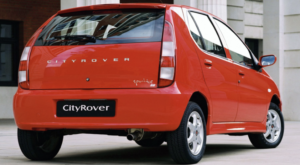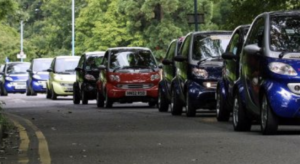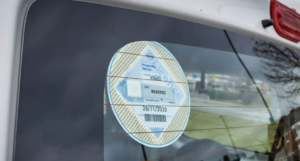Sadiq Will Set Me Free
Posted by Colin Lambert. Last updated: September 14, 2023
By City Rover
This month’s trip down memory lane takes us to February 2003. The Nasdaq was hovering around 1,000, still less than a quarter of the Dot-Com peak, EUR/USD was meandering around parity, and a glance back at the man maths spreadsheet reminds me it was a miserable year for bonuses.
It was into this rather subdued London mood, a full 20 years ago, that Mayor Ken Livingstone, one of Great Britain’s last bona fide communists, launched the Congestion Charge. From one day to the next, London’s motorists would be obliged to pay a fiver to drive into the centre of town, an area of about 22 square km from the City of London in the east, to the border of Park Lane in the West End. Naturally, Red Ken assured us that it wasn’t simply a revenue raising exercise, and glossed over the fact that his payment infrastructure was so poor that even the most well-meaning of motorists would collect any number of fines, no bargain either, a bullseye a pop.
Naturally, I objected to the scheme, and I wasn’t the only one. Congestion charging was criticised by politicians, an overwhelming majority of motorists, and even the trade unions. London’s Evening Standard newspaper was scathing about the charge, although in hindsight their journalistic neutrality was not enhanced by the Mayor accusing their reporter, Robin Hedges, of assaulting him at a party. By coincidence, that was the very same party at which Mr Hedges plunged over a 15-foot wall following an alleged tussle with the Mayor….[1]
Some of the more amusing opposition came from the Americans, whose embassy staff had determined the charge was in fact a tax like any other, for which they would be exempt as diplomatic staff. They simply refused to pay up, owing millions of pounds in charges by the time they moved out of the zone in Grosvenor Square and over to Battersea[2]. Now that New York has announced that its own Congestion Charge scheme has been approved[3], I do hope the Brits will try and get their own back.

Only missing the Hammer and Sickle
Faced with the new charge, most folks of a foreign exchange disposition did what we do best, by channelling our considerable brain power into finding novel and amusing ways to avoid it. I’m not saying it was limited to FX lags, but I recall a time when one trading floor in the City discussed nothing else.
And boy were we inventive.
We started small, very small. In 2003, Mercedes had just begun to import the original Smart car with the steering wheel on the correct side of the tiny cabin. A poverty spec running on steelies would set you back no more than 10 Silk Cut and a Mars bar. However, despite only having a sewing machine under the boot floor, and one of the worst automatic gearboxes ever to grace something engineered by Mercedes, the standard Smart could not escape Ken’s grasp.
Step forward a small garage under the railway arches in Shoreditch, east London, sadly long since gone and now a fair-trade sustainable organic Tofu delicatessen. A group of enterprising Jamaicans would convert your Smart car to LPG[4], fitting a large gas cylinder into the rear of the car, sitting directly above the engine, wedged into position between the backrest of the front seats and the boot lid. Voilà! your Smart car would now qualify as an ‘Alternative Fuel’ vehicle, you Sir, are free to sail past Ken’s cameras with nothing more than a middle finger raised in happy salute.
There were however a couple of small drawbacks with this solution, however. The first was the cost, I recall about £5k, so assuming a standard 252 trading days a year, that’s a four-year breakeven. This did not go down well, especially with the FX options traders, whose perpetual theta bills make them famously parsimonious; or put more succinctly, tighter than a camel’s backside in a sandstorm.
They were not keen on a four-year payback, even more so in light of a second issue that the LPG conversion raised: the very likely risk of death. The Smart car was made of flexible plastic, the reality of that construction method offering a crumple zone between the newly installed gas tank and a rear impact that was little more than a Rizla of perspex. One nudge up the rear from White Van Man and you would be certainly be launched into orbit by the exploding gas tank, effectively a scaled down Falcon Heavy booster rocket strapped to the front seats. Nobody liked the Congestion Charge, but it wasn’t worth dying for. A more vanilla solution was called for.

Cheap, but don’t have an accident
Enter the Private Hire Vehicles London Act (PHVLA) 1998. A dreary bit of legislation devised by Mayor Livingstone as yet another way to put his hand in the pocket of hard-working folks. Keen to curry favour with the famous London cabbies, Red Ken introduced a new law requiring mini-cabs and their drivers to be licensed, aiming to either reduce the number of mini-cabs competing with the black cabs on the streets of pre-Uber London, or raising money from licensing those that persisted.
As Conservative MP Jacob Rees-Mogg would put it, it was at this juncture that Red Ken was hoisted by his own petard. A deep-ish dive into the PHVLA found a rather strange anomaly. Doubtless in a bid to maximise revenues for the Mayor, the legislation separated the minicab vehicle from the driver, for the purposes of licensing both. And as such, it was the vehicle that became congestion charge exempt once registered, no matter who was driving it.
Back we all went to Hackney, not far from where the Tofu shop stands, to have the cars inspected at the Public Carriages Office (PCO). Less than £100 got you a cursory tug of the seatbelts, a bit of light nationalism, and the prized bright yellow disc, stuck top left in the windscreen: a notice to the CCTV cameras that your vehicle was now a licensed minicab and exempt from the congestion charge.
Soon there would be a long queue outside the inspection garage, no longer grey market Prius imports or Vauxhalls and Nissans wearing more miles than the Space Shuttle. Instead, a line of triple-black Range Rovers, AMG Mercedes and BMW M3s, each with a T.M. Lewin striped-cotton-shirted arm, finished off with cufflinks and a ‘ten bag Roley’, hanging lazily out of the window.

We loved this loophole. Even in a world without social media you could safely say it went viral. The PCO would publish an annual list of all car makes registered with them, and as the years went by and the bonuses went back up, the number of Porsche, Ferrari, and Lamborghini minicabs grew and grew. The list had Bentleys, Rolls Royces, and even a Bristol. Wonderful stuff, and best of all, it was legal and it was unlikely to result in third degree burns to your undercrackers.
Like all good things however, it came to an end, the blame squarely laid at the feet of an ill-informed FX lag in his new Jaguar XKR, a two-seater. Having roared away from the lights at the Angel Islington, our man noticed that the navy blue Mondeo disappearing in his mirrors had now turned on the blues and twos. The resulting conversation with the Rozzers centred not around the potency of the Jag’s launch control, nor the horsepowers delivered by the supercharged V8. “Why would Sir have his vehicle registered as a minicab when it only has two seats?”
Having jumped on a bandwagon, and being ignorant of the law, our man ‘fessed up. Very frustrating as, had he bothered to read the detail, he could easily have passed the car off as one that he lent out for wedding duties at the weekends, an activity for which you needed PCO registration and the yellow disc. Unforgiveable.
Once this story made the rounds, the PCO route was abandoned by most FX traders, the fear of illegality and conviction being too potent… so we went back to focus on our chatrooms instead.
So where did that leave us for the last decade? Mostly driving a succession of miserable cars that, for a snapshot in time, were each legitimately deemed exempt from the charge. The mayor moved these goalposts every couple of years: initially standard hybrids were exempt, hence the proliferation of Toyota’s Prius and the hateful Lexus SUV that I bought for the commute. There was a period soon after where vehicles with ultra-low emissions were exempt, and I found myself in a Citroen C1, followed by a Toyota Yaris hybrid. Plug-in hybrids came next, mostly Volvos, worthy but dull. Like broccoli.
Year after year of automotive purgatory, the desire not to pay the charge over-coming the desire to drive tastefully. With each passing season the charge increased inexorably, whilst the scope expanded, both in area and time. Soon all of central London was covered, and across the whole week. To drive your 2015 Range Rover TDV8 into the zone for Sunday lunch at the RAC Club in Pall Mall would cost you £27.50. Yes, you read that correctly, more than a bottle of the Club red (which is excellent by the way).
Opportunities for avoidance narrowed and narrowed, until the only safe space to be found in recent years was to drive an electric vehicle. And sure, you can convince yourself that your Porsche Taycan is all the car you ever need, but that won’t wash with your family when the eight-hour journey back from St. Ives in Cornwall to Notting Hill in London is extended by an additional six hours to take on enough amps to get you home.
At least all the spare time you now have waiting for, and waiting at, the one working charger on the A303 can be usefully spent online seeing how quickly electric cars are starting to depreciate now the first-mover nonsense has abated. That Taycan won’t return you a single Deutsche mark more than 40% of the £100k plus asking price you paid after 18 months of ownership. And that’s if you are really lucky.
So, let’s raise a glass to London Mayor Sadiq Khan. Other than answering the question “could anyone really be worse than Ken Livingstone” we do have one thing for which to be thankful. For Sadiq, from the rarefied atmosphere of his chauffeur driven LWB Range Rover, has signed a decree stating that from October 2025 there will be no more exemptions from any of his charges, neither the Congestion Charge, nor the Low Emissions Zone (LEZ), nor the expanded Ultra-Low Emissions Zone (ULEZ). All about clean air he says, nothing to do with the gigantic deficit run by Transport for London (which he controls), and rather conveniently ignoring the fact, so dirty is the air in the deep tube lines, you can actually see it.
But you know what, Sadiq? Knock yourself out. October 2025 sees the end of 22 years of compromise, of never driving the car I wanted to drive because I only cared about avoiding the charge. Thank you Sadiq, you have set me free – I can drive anything I want to because we all have to pay the same now. No more Toyota Yaris hybrid, no 998cc Citroen C1, no Smart bomb or Leaf. Not a Prius Insight.
City Rover’s recommendation?
A Mercedes G-wagen, and make it a diesel whilst you are at it. Order now as there is a two-year wait, avoid the crystal-meth spec and go for a deep red or navy blue with cream leather. Stronger than Tutankhamun’s tomb, the last car you ever need buy. Strongest residual values of any car on sale – go on, check: a three-year old version still costs as much as a new one.
Drive it to the Alps, drive it to Cornwall, drive it to Bishopsgate, drive it to City Hall. And if you see a blacked-out Range Rover when you get there, give the rather short fella inside a salute for me.

The last car you ever need to buy
[1] “I didn’t push him, nobody pushed him, it was an accident.”
[2] The U.S. Force has not paid this tax on the use of its official vehicles in the past and will not in the future – https://2009-2017.state.gov/s/l/2005/87224.htm#:~:text=Although%20to%20date%20the%20Embassy,will%20not%20in%20the%20future.
[3] https://www.nytimes.com/2023/06/26/nyregion/nyc-congestion-pricing.html
[4] Liquified Petroleum Gas for the uninitiated

